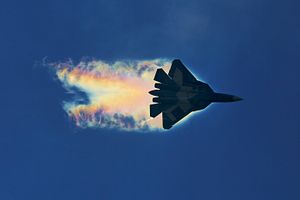During the annual India-Russia summit, which took place in late December 2015 in Moscow, Russian President Vladimir Putin and Indian Prime Minister Narendra Modi failed to resolve an ongoing disagreement between the two countries over the future of a joint fifth generation fighter program.
India and Russia in early 2007 signed an intergovernmental agreement to co-develop a fifth generation fighter–the Sukhol/HAL Fifth Generation Fighter Aircraft (FGFA) or as it known in India, the Perspective Multi-role Fighter (PMF). The aircraft will be a multi-role, single seat, twin-engine air superiority/deep air support fighter with stealth capabilities and is based on the Sukhoi PAK FA (Prospective Airborne Complex of Frontline Aviation) T-50 prototype, currently undergoing flight tests in Russia.
Ever since 2007, however, the weapons program has experienced various setbacks.
Delays were caused by New Delhi and Moscow disagreeing over many fundamental aspects of the joint development project including work and cost share, aircraft technology, as well as the number of aircraft to be ordered. After evaluating the first PAK FA T-50 prototype, the Indian Air Force (IAF) wanted more than 40 changes addressing, among other things, perceived weaknesses in the plane’s engine, stealth and weapon-carrying capabilities.
While a preliminary $295 million design contract was signed in 2010, the final design contract under which both sides agreed to contribute each $6 billion for design and production and which also included a fixed order of 154 aircraft, a compromise on work share, a firm commitment to the number of single- versus double-seat aircraft still has not been signed to date. (Even though the head of Russia’s United Aircraft Corporation (UAC) announced last June that a full R&D collaboration contract would be signed in 2015.)
As I reported before, the fifth generation fighter jet was slated to be introduced into the Indian Air Force by 2022. Russia was supposed to receive 250 aircraft, whereas India downgraded its initial purchasing size from 200 to 144 planes in 2012 at an estimated total cost of $30 billion. However in late 2015, Russian Deputy Minister Yuri Borisov announced that the Russian Air Force would only purchase a squadron (18-24 aircraft) of PAK FA fighter jets, and procure additional Sukhoi Su-35 aircraft instead.
The announcement apparently finally made India lose faith in the program. Last month, Russia tried to salvage the joint project by making India an offer to cut down its financial contribution from 6 to $ 3.7 billion for three PAK FA T-50 prototypes and technology transfers, The Indian Express reported.
“Now that they already have the fighter, the Russians have made a revised offer to us. For $3.7 billion, they will give us all the technological know-how of making the fighter. We will also get three prototypes from them in that amount,” a senior Indian defense official told the paper.
However, a senior IAF official told the paper that the air force remains skeptical: “We are not in favor of the FGFA. The PAK FA fighter is too expensive at even this rate, and we are not sure of its capabilities.”
The meeting between President Vladimir Putin and Indian Prime Minister Narendra Modi was supposed to lead to some sort of compromise, but without even a revised signed design contract the project’s future will remain in limbo.
Meanwhile, the Russia’s Defense Ministry announced that the PAK FA T-50 prototype has “practically completed” flight tests and will be inducted into the Russian Air and Space Force in 2017. So far, four PAK FA T-50 prototypes, along with two test beds of the fighter, have been delivered by Sukhoi to the Russian military and are currently undergoing extensive testing. Three more prototypes are expected to be delivered in early 2016.































